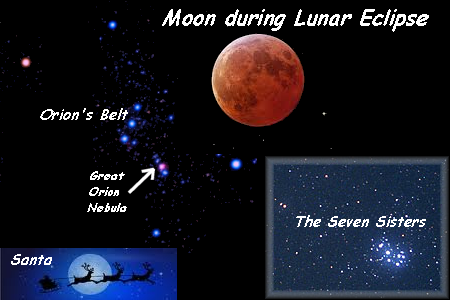Lunar Eclipse on Eve of Solstice – Santa isn’t the only thing in the winter sky . . .
 By Donald McBrayer
By Donald McBrayer
On the morning of December 21, just 15 hours before the winter solstice you’ll get a chance to witness the first total lunar eclipse in nearly 3 years. A total lunar eclipse happens when the shadow of the Earth passes over the surface of the moon completely covering it. The lunar eclipse begins at 1:35 AM and will last about 90 minutes.
The Moon will be easy to spot high in the southern sky near the borders of the constellations Taurus, and Orion. During the peak of the lunar eclipse the Moon will appear brownish orange or brick red and the sky will grow darker, allowing the bright winter stars surrounding our celestial neighbor to sparkle in prominence. Unlike a solar eclipse (the moon’s shadow passing over the Earth), a lunar eclipse is completely safe to watch.
While you’re looking up, glance a bit west of the eclipse to notice the sky’s brightest star cluster, the Pleiades (M45), also know as The Seven Sisters, in the constellation Taurus. This star cluster can be viewed almost any winter night, and is a marvel to look at through binoculars. Another wonder to check out with binoculars is the Great Orion Nebula (M42). This murky star nursery is located just under Orion’s Belt (three stars in the center of the Orion Constellation), and is 24 light years wide.
Weather is the only thing that will disrupt the view so if you miss this year’s lunar eclipse you’ll have to wait till April 2014 to catch the next one.
Posted: December 18th, 2010 under General News.
